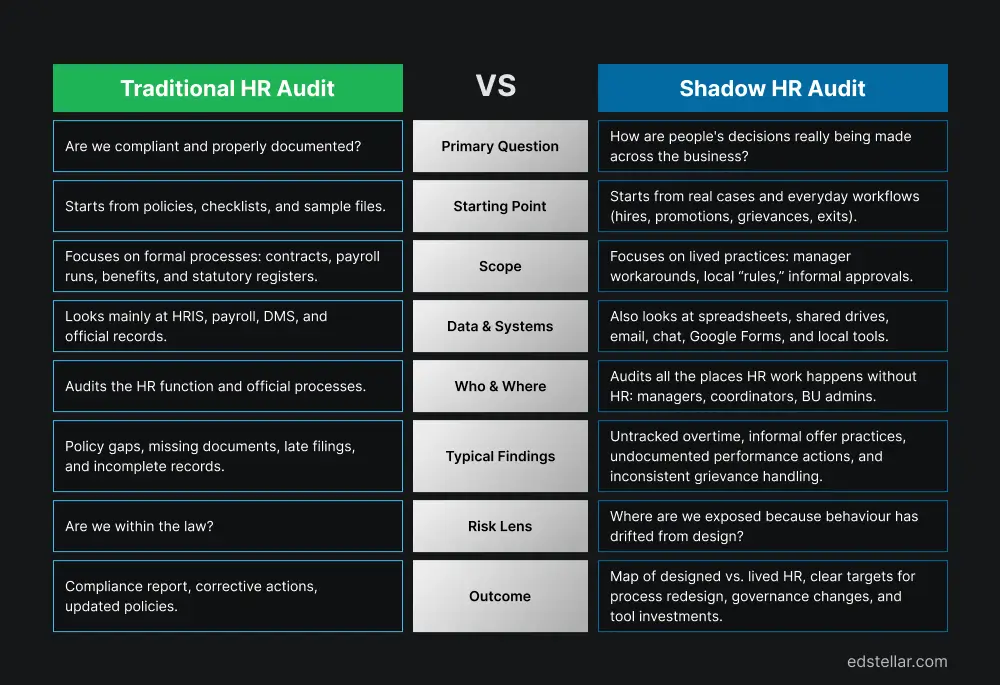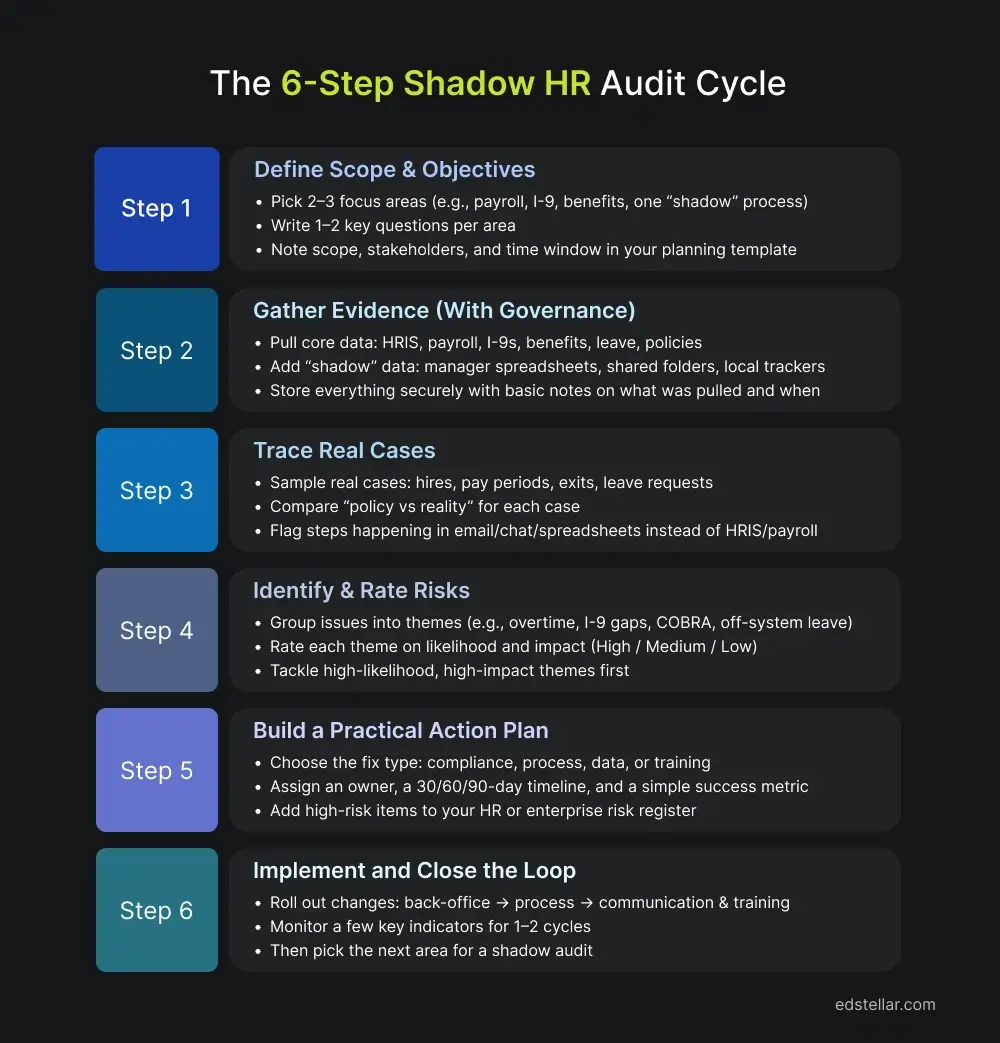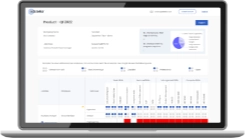
You can have solid policies and clean compliance reports, yet still get blindsided by an HR issue that “shouldn’t have happened,” a pay practice in one unit that doesn’t match policy, a spike in exits in a critical team, or a sensitive case that reaches Legal before it reaches you.
At the same time, the way work gets done has changed. More of your organisation’s output now runs through projects, digital talent platforms, and blended workforces. Research from Harvard Business School shows these on-demand talent models are already mainstream and expected to grow as leaders use them to close skill gaps and move faster.
Put those together, and a hard question emerges: how confident are you that you really see what is happening outside your core HR systems and formal processes, where managers, project leads, and local teams are making day-to-day people decisions? Green dashboards don’t automatically mean you have that visibility.
A shadow HR audit is a structured way to go after that gap. Instead of repeating standard compliance checks, it focuses on a few high-stakes areas like pay, time, hiring, exits, and employee relations. It looks at how decisions are actually being made and recorded in the business, so you can catch issues before they show up as complaints, investigations, or board-level surprises.
In the next section, we’ll look at how a shadow HR audit actually works in practice and how to use it to surface issues early without turning it into a witch-hunt or a massive HR project.
Understanding Shadow HR Audits: Beyond Traditional Compliance Checks
Most HR leaders know how a standard HR audit works.
You review policies and sample files, check payroll and benefits, and confirm compliance and documentation. It shows how your HR function appears on record.
A shadow HR audit asks a different question: How are people's decisions actually being made across the business, day to day?

Instead of starting with policy binders, it starts with how work really runs:
- How a manager actually hires when they're under pressure to fill a role
- How overtime is really tracked on the shop floor or in remote teams
- How performance feedback, warnings, and exits are handled when HR isn't in the room
You're not asking, "Do we have a policy?"
You're asking, "What really happened here?"
In practice, a shadow HR audit usually focuses on three layers:
- Workflows: The real steps managers and HRBPs follow for hiring, pay changes, performance management, grievances, and exits, not just what's written in the SOP.
- Systems and Artefacts: HRIS and payroll, yes, but also spreadsheets, shared drives, Google Forms, email trails, and chat threads where attendance, overtime, approvals, and complaints are actually tracked.
- Decision Paths: Who really approves what, who can override, and where "one-time exceptions" have quietly become the norm in certain teams or locations.
A simple way to run it is to take a small set of real cases, new hires, promotions, grievances, terminations, and trace them end to end:
- What should have happened according to policy?
- What actually happened in practice?
- Where did the process leave no trace in the official systems?
Patterns show up fast: offers issued before HR sign-off, team-owned attendance sheets that don't match payroll, remote managers handling performance entirely over chat with no documentation.
That is the terrain a shadow HR audit is designed to map. This is why it goes beyond a traditional compliance check.
A conventional audit asks: "Are we compliant and within the law?"
A shadow HR audit adds: "Where are we exposed because everyday behaviour has drifted away from our designed process?"
If you like analogies, think of it this way:
- A traditional audit checks the playbook.
- A shadow audit watches how the game is actually played.
Both matter, but they answer different questions.
Done well, a shadow HR audit is a structured way to:
- Surface the gap between designed HR and lived HR
- Understand why managers are building workarounds in the first place
- Identify where you need better processes, clearer governance, or smarter tools
Once you can see those gaps clearly, the value story becomes much easier to quantify.
Why Shadow HR Audits Deliver ROI
Once you see what a shadow HR audit actually looks at, the value question becomes simple: Is it cheaper to discover issues on your terms, or to have them discovered for you by a regulator, a lawyer, or an employee complaint?
Shadow HR audits are, at their core, a way to move problems from the “expensive and public” bucket into the “manageable and quiet” bucket.
For a wider view of the HR risk landscape behind these issues, see HR Risk Management: 5 Critical Threats Every Organization Must Address.
You don’t need hero numbers to make the case. You just need to look at where money, time, and leadership attention actually leak today.
1. Avoiding Expensive Surprises
The most obvious lever is risk and penalties.
A lot of HR exposure doesn’t come from exotic situations; it comes from small issues repeated at scale:
- A classification mistake that affects a whole team, not one person
- Over time, practices that have become “how we do things” in one location
- Informal grievance handling that never gets documented until a lawyer is involved
A shadow HR audit catches these patterns while they are still internal problems, not external cases.
Instead of discovering, two years later, that a group of employees has a credible wage-and-hour or discrimination claim, you:
- See the pattern early
- Fix the practice
- Make employees whole where needed
- Close the loop before it turns into litigation or a regulatory finding
You don’t have to pretend there’s a universal “$100,000 average violation.”
It’s enough to be honest: One prevented a six-figure issue pays for years of sensible auditing.
2. Reducing Rework and Firefighting
The second lever is quieter but just as costly: rework.
When real behaviour drifts away from the designed process, HR teams spend their time:
- Manually fixing payroll exceptions at month-end
- Cleaning up mismatched headcount numbers between HR, finance, and business units
- Retro-filling documentation after the fact because something “wasn’t logged properly”
- Jumping into last-minute escalations that could have been prevented with clearer rules
A good shadow HR audit doesn’t just say, “Here’s a risk.” It shows you where the process forces people into workarounds.
Fixing those root causes means:
- Fewer one-off exceptions to process
- Fewer manual corrections and reconciliations
- Fewer urgent calls from managers asking, “Can you sort this out today?”
That reclaimed capacity is not abstract. It’s HR time you can move from firefighting to designing better systems, supporting leaders, and driving change.
3. Getting to Reliable People Data
Most executive frustration with HR data comes down to one simple thing: they don’t trust the numbers.
Shadow HR audits expose why:
- HRIS says one headcount, finance says another, and the BU’s spreadsheet says a third
- Leaves, overtime, or variable pay are being tracked locally, then keyed in manually later
- Performance and ER history exist in email or chat, not in any system of record
You can’t run serious workforce planning, cost analysis, or org design on shaky data.
By mapping all the places where HR-critical information actually lives and deciding what becomes the single source of truth, you:
- Reduce conflicting versions of headcount, cost, and risk
- Make reporting faster and more reliable
- Give the C-suite more confidence in people-related decisions
That trust has a direct impact: when leaders believe the data, they’re willing to act on it.
4. Protecting Leadership Focus and Reputation
The last lever is leadership attention.
Every major HR failure, public investigation, messy exit, discrimination claim, wage-and-hour issue comes with hidden costs:
- Weeks or months of leadership time spent in reviews, hearings, and internal inquiries
- Morale damage in teams watching how the situation is handled
- External brand impact with candidates, customers, or regulators
A shadow HR audit won’t eliminate all risk, but it significantly reduces the number of “we should have seen this coming” moments.
Instead of spending time defending past processes, leadership can spend time:
- Communicating improvements
- Strengthening culture and manager capability
- Focusing on growth and transformation, not clean-up
A Simple Scenario You Can Use in the Boardroom
When you need to explain this to a CEO or CFO, you don’t need a glossy case study. A grounded scenario works better:
That’s the business case: not magic ROI percentages, but fewer nasty surprises, less waste, and better decisions.
The 6-Step Shadow HR Audit Framework
Think of this framework as a short, contained audit cycle, not a giant transformation program. The goal is simple: pick a few high-risk areas, see how they really work, and come out with a small number of fixes you can defend to Legal, Finance, and the business.

Step 1: Define Scope and Objectives
Start narrow on purpose. Two or three focus areas are usually enough for a first shadow audit.
For a Us-based Organisation, Common High-risk Candidates Are:
- Payroll compliance: overtime calculations, exempt vs non-exempt classification, wage-and-hour adherence
- I-9 documentation: eligibility verification, document retention, re-verification for expiring work authorisations
- Benefits administration: COBRA notices and timelines, ACA reporting, FMLA, and state leave administration
You Can Also Add One “shadow Practice” Flow Where You Know Manager Behaviour Matters a Lot, for Example:
- Offers and compensation approvals in sales or tech
- How ER issues are handled in a specific business unit
- How exits are processed in a high-turnover location
For Each Focus Area, Write down One or Two Concrete Objectives, Such As:
- “Confirm whether overtime is being calculated and paid correctly for non-exempt employees in X location over the last 6–12 months.”
- “Verify that I-9s are complete, timely, and properly retained for all hires in the past 24 months.”
- “Check whether COBRA notices have been sent consistently and within required timeframes for all qualifying events in the last year.”
Use Your Shadow Hr Audit Planning Template Here to Capture:
- Scope and focus areas
- Key stakeholders (HR, Legal, Finance, BU leaders)
- Time window and population in scope
- High-level questions you want answered
A typical pilot cycle runs 4–8 weeks, depending on your size and data complexity.
Step 2: Gather Evidence with Governance, Not Secrecy
You don’t need to sneak around to get authentic findings. You do need to be disciplined and low-drama.
Once the scope is agreed with the CHRO and, where appropriate, Legal and Internal Audit:
Pull Core Data and Documents for the Period in Scope, for Example:
- Payroll registers and time records for selected groups
- I-9 forms and supporting documentation for a recent hiring window
- Benefits enrollment, COBRA notices, and leave management records
- Relevant policies, SOPs, and process guides for each area
Include the “shadow Layer” Where It Exists:
- Manager or local HR spreadsheets for time, attendance, or exceptions
- Shared folders where offers, promotions, or ER notes are tracked
- Any local trackers used for leaves, schedules, or variable pay
Keep It Governed and Secure:
- Access data through normal channels with appropriate approvals
- Store audit materials in a secure, access-controlled location
- Note when and from where each data set was pulled
The point is to build a single view of evidence for each focus area, not to surprise your own systems team.
Step 3: Trace Real Cases and Test How Processes Actually Run
Instead of creating dummy scenarios, use real cases. They’re cleaner, more honest, and less disruptive.
For each focus area:
Sample a Handful of Real Transactions, for Example:
- A set of pay periods for a group of non-exempt employees
- A group of recent hires across different locations for I-9s
- Recent terminations that should have triggered COBRA
- A few FMLA or state leave cases, including borderline situations
Trace Each Case End-to-end:
- What should have happened according to policy and process?
- What actually happened in practice?
- Which steps left a trace in HRIS/payroll/benefits systems, and which only live in email, chat, or spreadsheets?
Do a Small Number of Process Walk-throughs:
- Sit down (virtually or in person) with a manager, HRBP, or payroll/benefits specialist
- Ask them to “show how you actually do this here” on screen or with a simple flow sketch
Capture where the process diverges from design and where decisions or approvals are happening outside your formal systems.
Step 4: Identify and Rate Risks
Once you’ve seen how things really work, you need a simple way to prioritise what you’ve found.
Use a Basic Matrix:
- Likelihood: How often does this happen? Is it an isolated exception, or a pattern in a team, location, or population?
- Impact: If this continues, what’s at stake?
- Regulatory: wage-and-hour, immigration, benefits, leave laws
- Financial: back pay, penalties, legal fees, remediation costs
- People and Reputation: fairness, discrimination patterns, complaints, external brand
Mark each theme or issue as High / Medium / Low on both dimensions, and focus first on:
High Likelihood / High Impact Issues, Such as:
- Systematic overtime miscalculation for a group of non-exempt employees
- Consistent I-9 gaps for specific locations or hiring channels
- Repeated COBRA notice failures after particular types of exits
- Leave cases routinely handled off-system in one business unit
Document:
- What the issue is
- Where it shows up (teams, locations, roles)
- Why do you consider it high, medium, or low risk
This doesn’t have to be perfect. It just has to be clear enough for HR, Legal, and the business to agree where to act first.
Step 5: Build a Practical Action Plan
A shadow audit is useless if it stops at a findings deck. You need a short, concrete plan that someone actually owns.
For each high and medium-risk item:
Decide the Type of Response:
- Immediate compliance fix (e.g., correct pay and notices, close obvious gaps)
- Process change (e.g., tighten approvals, clarify roles, standardise steps)
- Data and systems fix (e.g., clean up records, close spreadsheets, move key fields into HRIS)
- Capability and guidance (e.g., focused training or job aids for managers and HR)
Assign Clear Ownership and Timelines:
- Who is accountable for fixing this (HR Ops, Payroll, Benefits, ER, BU leader, etc.)?
- What will be done in the next 30, 60, and 90 days?
- How will you know it’s actually fixed (simple success measures)?
Connect High-risk Items to Formal Governance:
- Log them in your HR or enterprise risk register where appropriate
- Agree how and when they will be reported upwards (CHRO, CFO, Audit/Risk Committee)
You Can Use the Second Part of Your Shadow HR Audit Planning Template to Capture:
- Each issue
- Owner
- Actions
- Target dates
- Status
Step 6: Implement and Close the Loop
Implementation doesn’t need to be dramatic, but it does need to be visible to the right people.
Sequence Changes Sensibly:
- Start with back-office fixes (configuration changes, data clean-up, standardising templates)
- Then adjust manager-facing processes where needed
- Finally, reinforce with targeted communication and training
Be Honest, Not Alarmist, in Communication:
- With leadership: “Here’s what we found, what we’ve already fixed, and what’s in motion.”
- With HR and key managers: “We saw some patterns in how X is handled; here’s the simpler, safer way we’re moving to.”
Monitor for a Short Period, Then Fold into Bau:
- Track a few simple indicators for the next 1–2 cycles (e.g., pay corrections, I-9 exception rates, missed COBRA triggers, off-system leave tracking)
- If needed, schedule a light follow-up shadow review in the same area after 6–12 months
The Aim isn’t Perfection. It’s to Show That:
- You can spot where HR has drifted from the designed HR
- You can fix the most important issues without creating chaos
- You can explain to your CEO, CFO, and board what you’ve done and how you’re reducing risk going forward
Tools & Technology: Enabling Efficient Shadow Audits
In most organizations, 70–80% of what you need is already in your stack; it’s just underused or not connected in the right way.
The role of technology here is simple: Make it easier to follow real cases end-to-end, compare systems, and track what you find without turning the whole thing into a massive project.
Start With What You Already Have
For a shadow audit, a few core capabilities matter far more than specific brand names:
HRIS / HCM (system of record)
This is your starting point for official data: headcount, roles, pay, status, and manager relationships.
Use it to pull clean extracts of employees in scope, job details, and key events.
Payroll System
This is where reality shows up in money.
Use it to cross-check actual pay, overtime, allowances, and deductions against what HRIS and policy say should happen.
Collaboration & File Tools (SharePoint, Google Drive, Teams, etc.)
These hold the “shadow layer”: trackers, local templates, and shared folders.
Use them to locate manager-owned spreadsheets, local logs, and side documents that carry HR-relevant decisions.
Reporting / BI layer (e.g., your existing dashboards)
Even basic reporting can help you spot patterns.
Use simple views to compare different data sources (HRIS vs payroll vs local trackers) and flag inconsistencies.
Case/Ticketing Tools (if you have them)
HR service desks, ER case tools, or even IT ticketing can be repurposed.
Use them to log findings, assign owners, and track remediation rather than managing everything in email threads.
If you can:
- Export data
- Trace a case across systems
- Attach notes and actions somewhere visible
You already have enough tech to run a useful first shadow audit.
The Capabilities That Really Matter
Instead of thinking “Which tool should I buy?”, focus on “What must be true in our environment?”:
- Data Access and Export: Can we easily pull the data we need from HRIS, payroll, and key trackers for a defined period?
- Audit Trails and Change Logs: Can we see who changed what, and when, for sensitive fields like pay, grade, status, or manager?
- Cross-Checks Across Systems: Can we compare HRIS vs payroll vs local files without days of manual work?
- Simple Pattern Detection: Can we group and filter by BU, manager, location, and employment type to see where issues cluster?
- Finding and Action Tracking: Do we have one place to list findings, rate risks, assign owners, and track progress?
If those five boxes are ticked, the technology is “good enough” for a serious shadow audit.
If you’re also exploring how better skills data can strengthen these decisions, our article on 7 Ways Skills Intelligence is Changing HR Tech is a useful next read.
Optional Accelerators (If You Have Them)
Some organizations already use risk or GRC tools, survey platforms, or advanced BI. Those can help, but they’re accelerators, not prerequisites:
- GRC / risk platforms can host a formal risk register and link findings to enterprise risk reporting
- Survey or pulse tools can quickly collect “this is how we really do it” input from managers in different BUs
- More advanced BI can help you spot patterns faster (for example, clusters of exceptions in a region or role family)
Use them if they’re there. Don’t make them the barrier to starting.
Keeping the Tech Piece Practical
The real trap is over-tooling. You don’t need a “shadow audit system.” You need a lightweight way to:
- Pull data from existing systems
- Overlay it with what you learn from interviews and case reviews
- Log what you find and what you’re going to fix
If your HRIS, payroll, and reporting tools are underused today, getting more out of them will do more for your shadow audit than adding another platform on top.
Common Mistakes to Avoid: Learning from Others' Pitfalls
Even the best-intentioned shadow HR audits can backfire if they’re run in the wrong way.
What follows are the patterns that trip leaders up most often and what to do instead.
Plan Ahead to Avoid These Pitfalls
Before you launch, hold a short pre-audit planning session with:
- CHRO and HR leadership
- Legal (and Internal Audit / Risk, if needed)
- One or two business leaders from the areas in scope
Agree on:
- Scope and priorities
- Communication boundaries (who needs to know what, and when)
- Documentation standards
- How and where findings will be tracked and reviewed
A bit of discipline up front will save you months of friction later.
How You’ll Know It’s Working
You don’t need fancy dashboards to see early signs of success. Look for:
- Fewer last-minute payroll corrections and manual fixes
- Smaller gaps between HRIS and finance headcount numbers
- A drop in off-cycle exceptions (special titles, ad-hoc payments, one-off rule bending)
- Fewer “we had no idea this was happening” moments in leadership meetings
- Leaders are starting to call HR earlier, not only when something has already gone wrong
If those patterns start to shift, your shadow audit program is not just finding issues; it’s changing how the organization actually runs.
Quick Start Guide: Your First 4 Week Plan
Think of your first shadow HR audit as a pilot, not a grand program.
In 30 days, your job isn’t to “fix HR,” it’s to run one contained experiment that:
- Surfaces the real gaps between designed and lived HR
- Proves the value of the approach
- Gives you something concrete to show your CEO/CFO/CHRO peers
A simple way to structure it is by weeks, not by micromanaged days.
Week 1: Frame and Align
Goal: Decide where you’ll pilot and who is in the tent.
Pick one or two concrete flows in one business area, for example:
- Overtime and scheduling in a plant or operations team
- Hiring and offers in one sales or tech BU
- Performance and ER handling in a specific high-risk unit
Align with the right people:
- CHRO / HR leadership
- Legal (non-negotiable if you’re touching sensitive risk)
- Internal Audit or Risk (if your org has a formal risk framework)
- The BU leader whose area you’re piloting in
Agree, in plain language:
- What you’re looking at (scope)
- The focus is on systems and patterns, not blame
- How findings will be documented and where they’ll go
This is where your “Shadow Audit Planning Template” and a simple 30-Day Checklist can help: capture scope, stakeholders, timelines, and basic rules of engagement in one place.
Week 2: Collect and Map Reality
Goal: See how work actually runs today.
Pull the core data and documents for your chosen flows:
- HRIS and payroll extracts for people in scope
- Local trackers (spreadsheets, shared folders) that the BU uses
- Relevant policies, SOPs, and process guides
Trace a handful of real cases end-to-end:
- A few hires, exits, promotions, grievances, or overtime cycles
- What should have happened vs what actually happened
Do a small number of process walk-throughs:
- 3–5 conversations with managers, HRBPs, or admins
- “Show me how you actually do this here,” on screen or whiteboard
By the end of Week 2, you’re not trying to have a full report.
You just want a clear picture of where the designed and lived HR diverge in this one area.
Week 3: Analyse and Prioritise
Goal: Turn observations into a short, sharp list of issues that matter.
Cluster your findings into a small set of themes, such as:
- “Shadow spreadsheets driving overtime decisions”
- “Offers issued before HR approval”
- “Performance actions handled in chat, not recorded anywhere”
For each theme, rate:
- Risk (regulatory, financial, fairness, reputational)
- Effort to fix (quick process tweak vs tech change vs full project)
Align again with Legal and the BU leader:
- Sanity-check your risk view
- Decide what must be addressed now vs what can move into the broader HR or risk roadmap
You’re aiming for a short list of priority issues, not an encyclopaedia.
Week 4: Act and Decide How to Continue
Goal: Prove movement, not perfection.
Pick one or two quick, visible fixes you can genuinely start:
- Tightening an approval path
- Cleaning up a critical tracker and moving key data into HRIS/payroll
- Clarifying a policy that everyone is “interpreting” their own way
For more complex items:
- Log them formally in your risk/remediation tracking (HR, Legal, or Enterprise Risk, depending on your org)
- Agree on owners and rough timelines
Share a simple, honest summary with sponsors:
- What you looked at
- What you found (themes, not gory detail)
- What you’ve already started fixing
- What’s going into the longer-term pipeline
The win in Month 1 is not a perfect system. It’s:
- One contained a shadow audit, done end-to-end
- A few tangible improvements
- Leadership says, “This is useful, let’s repeat it in other areas.”
If you want to make this even easier for your team, package this into a 30-Day Shadow Audit Checklist.
Conclusion
You don’t need a huge programme to change how risk shows up in HR. A shadow HR audit is simply a disciplined way to see where reality has drifted, fix what matters most, and walk into executive conversations with fewer surprises and clearer answers.
If you strip it down, your job is straightforward: pick one or two high-stakes areas, follow a few real cases end-to-end, quantify the risk, and close the loop with visible fixes. Do that once in 30 days and you’ve moved shadow audits from theory to a repeatable management discipline, not a one-off fire drill.
Where it gets interesting is what happens after the first audit. You’ll almost always uncover patterns that tie back to capability and systems: managers improvising because they’ve never been trained properly, HR teams working around clunky tools, skills that haven’t kept pace with new regulations or talent models. That’s where a partner like Edstellar can help you turn findings into long-term advantage, not just short-term clean-up.
On the capability side, Edstellar can help you upskill the people who run and respond to these audits, with instructor-led programs in HR compliance, HRMS/HRIS, payroll management, and risk-sensitive HR operations for HR, payroll, and line managers.
On the systems side, Edstellar’s AI-powered Skill Intelligence and Skill Matrix tools let you map skills across teams, pinpoint gaps exposed by the audit, and target training where it will actually reduce risk and improve execution, rather than guessing. And with training management software that integrates into your HRMS, you can schedule, track, and report on these interventions without adding another shadow spreadsheet to the pile.
You don’t have to fix everything at once. Start with a single shadow HR audit, use the planning template to keep it contained and honest, and prove to yourself and your leadership team that you can see the whole picture, not just the official one.
From there, you can decide where to run the next cycle and which skills, tools, and partners you want by your side as you do.
Frequently Asked Questions
Explore High-impact instructor-led training for your teams.
#On-site #Virtual #GroupTraining #Customized

Bridge the Gap Between Learning & Performance
Turn Your Training Programs Into Revenue Drivers.
Schedule a ConsultationEdstellar Training Catalog
Explore 2000+ industry ready instructor-led training programs.

Coaching that Unlocks Potential
Create dynamic leaders and cohesive teams. Learn more now!


Want to evaluate your team’s skill gaps?
Do a quick Skill gap analysis with Edstellar’s Free Skill Matrix tool

Transform Your L&D Strategy Today
Unlock premium resources, tools, and frameworks designed for HR and learning professionals. Our L&D Hub gives you everything needed to elevate your organization's training approach.
Access L&D Hub Resources.svg)
.svg)



.svg)


.svg)
.svg)
.svg)
.svg)

